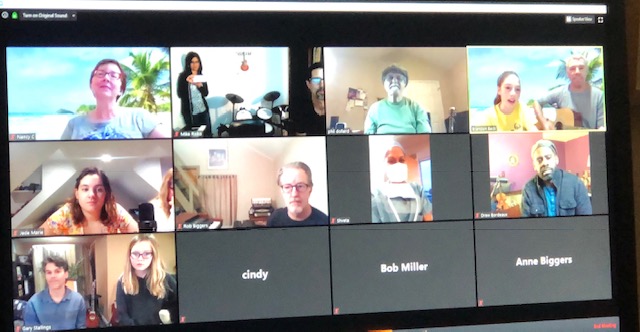Even if customers are now allowed in your store, Zoom has become and will remain a valuable online resource for MI retailers.
Some years ago, we began offering live video lessons via Zoom at our music store/school, so we were well prepared when COVID-19 forced us to close our physical doors to customers in March. We began moving other parts of our business to video, including our popular open-mic nights.
We’d long offered a free monthly open-mic night to the community, because we’d found it to be a great way to bring adult musicians of all levels into our store. Now, though, with the store closed until late May and the community under stay-at-home orders, we sensed that musicians would be even more eager for opportunities to display their talents, so we decided to bring our open mics to computer screens immediately and to hold them once a week instead of monthly.
If anything, we underestimated the desire of musicians to get together in this unprecedented time. Our first virtual open-mic night was met with the most amazing enthusiasm. Not only did our local musician friends log on in great numbers, we were also able to reconnect with musicians who had left the area, and even some of the friends we’ve made over the years at NAMM shows who live around the country logged in to catch up with us. With all the guitarists, pianists, singers and ukulele players who signed up to perform, we couldn’t have been more pleased with the evening.
Four Technical Tips for Zoom
1. Invest in a decent USB microphone. Your audio will sound more full and more professional.
2. Make sure you have a good camera. Many built-in computer cameras are of great quality and work well, but if your camera is lacking, an investment of $70 for a USB camera can offer your audience a much better visual experience.
3. Create proper lighting. The light source should be behind the camera, not behind you. This includes sunlight from a window.
4. Keep the background noise to a minimum. During an open mic, mute yourself while you are watching other performances.
What a delight when our second virtual open-mic night doubled in size! Local musicians invited out-of-town friends to watch or perform, and the evening turned into a welcome break from an endless diet of pandemic news. Participants were also able to enjoy a glass of wine in their homes during the performances without worrying about having to drive afterward. And, best of all, as hosts, we had no setup or cleanup to deal with. We simply logged in, ran the show and logged out at the end.
Our Zoom open mics have been such a big plus for us that we intend to continue with them even after our stay-at-home order is lifted. If you think something along the same lines might benefit you, here’s how you can create your own Zoom open mic at your music store or school.
- Pick an evening that works for you, and be consistent. Consistency will ensure that you have a regular crowd every time. We find it’s best to hold the events after dinner, though you can also encourage people to eat during them.
- Make sure your open mic is presided over by a host who can keep things running smoothly and engage the musicians in conversations. We get a lot of singer/songwriters at our open mics, and it’s fun to ask them about the material they’ve written.
- Encourage musicians to attend even on nights when not enough time is available for all of them to perform. We find musicians as a group are very sympathetic and happy to listen to others.
- Have some basic rules. Performers should restrict themselves to one or two songs. You should also have them register in advance and list what they plan to play, so you can introduce them properly. We ask participants to e-mail us to reserve a slot and, when we have 10 musicians, we stop accepting more, though we continue to welcome audience members. Also, you should remind all audience members to mute their devices during performances. It’s nice when people unmute at the end of a song so they can applaud the performer.
- Encourage a little conversation among participants. Especially now, when people are feeling isolated, this is a really good way for musicians to connect with their peers.
- Promote your open mic on your local Facebook pages. You may not find a lot of musicians that way, but you’ll find plenty of people who like to watch them. Encourage all participants to follow you on social media, and be sure to take pictures and video and post them afterward, so people can enjoy highlights of the show.
- Use a little time to promote your business during the open mic. Whether you’re telling audience members about a new product or a new program, these are people who are definitely fans of yours and who are apt to be receptive to new offerings. Also, host your open mic from inside your store, if possible (and if you’re allowed to), and do a tour of the store during it, so you can show off your gear. While we understand that some businesses might like to charge a small fee for participation in an open mic, we choose not to do that, because we find that the amount of goodwill these occasions generate more than makes up for the free admission.
We intend to keep these events going even after life returns to normal. Our plan is to do a combination of video and in-person open mics on a more regular basis than before the COVID-19 crisis, which, though it may have forced the closure of many doors, will never stop the music!
To read more columns from the Music & Sound Retailer, click here.


